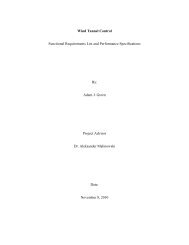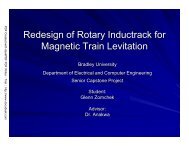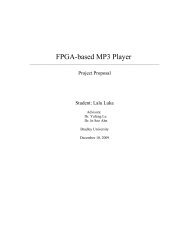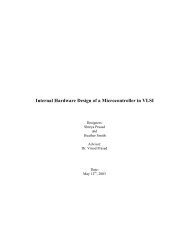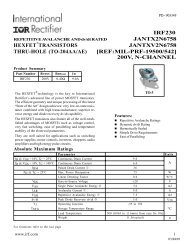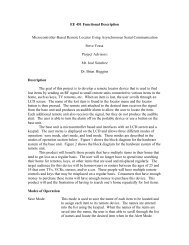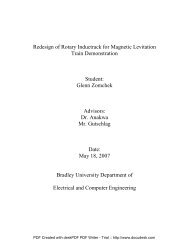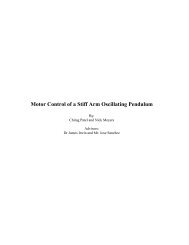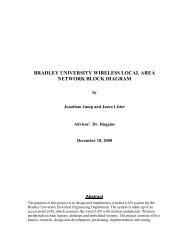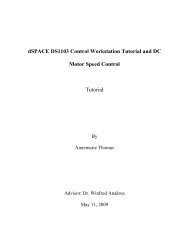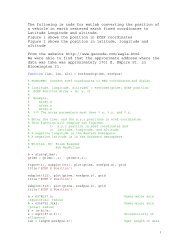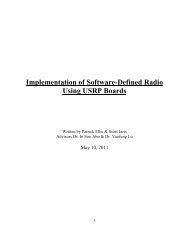Project Proposal - Bradley University ECE department
Project Proposal - Bradley University ECE department
Project Proposal - Bradley University ECE department
You also want an ePaper? Increase the reach of your titles
YUMPU automatically turns print PDFs into web optimized ePapers that Google loves.
<strong>Project</strong> Summary<br />
The purpose of this project is to upgrade the controls on the Mechanical Engineering<br />
Department’s wind tunnel. The end goal is to create an easy to use user interface that<br />
will allow for both manual control of the wind tunnel and for executing predefined tests<br />
in the form of control sequences for the wind tunnel. In addition, the project will include<br />
the ability for remote operation of the wind tunnel for educational use such as in high<br />
schools. In order to make the system more robust, new National Instruments (NI)<br />
hardware will be installed. The new NI hardware will streamline the user input LabView<br />
control application with the new NI controller running LabView code.<br />
Detailed Description<br />
The Mechanical Engineering <strong>department</strong> would like to make measurements in their<br />
tunnel while using automated test sequences and to update their wind tunnel with a<br />
remote monitoring option for potential remote learning activity. In the past three years,<br />
three senior projects have made progress towards this end. The major missing<br />
component of these projects has been reliable components for the industrial environment.<br />
The block diagram in figure 1 shows the overview block diagram of the entire project<br />
that will be used to add this reliability. <strong>Bradley</strong> <strong>University</strong> students and professors will<br />
be able to control the wind tunnel through a LabView application with advanced direct<br />
control features and with automated test capabilities. Data from wind tunnel tests will be<br />
available in real time and through spreadsheets written with the test data. Drag force, lift<br />
force, pressure in the wind tunnel, pressure outside the wind tunnel, temperature in the<br />
wind tunnel, and temperature outside the wind tunnel will all be measured. A second<br />
application with simplified direct controls will allow high schools to run the wind tunnel<br />
from a remote location over an internet connection. Authentication will be required<br />
before either application is given control of the wind tunnel. Communication from the<br />
control applications will be sent over the Internet and through a network address<br />
translation router to the NI hardware. The NI hardware will have sole control over the<br />
operations of the wind tunnel when enabled. In case of extended connection loss with the<br />
control application the NI hardware will automatically safely shutdown the wind tunnel.<br />
In addition, if power is lost during a test the wind tunnel will shutdown and remain<br />
shutdown. Cameras will also be connected to the network so that wind tunnel tests can<br />
be observed remotely. Three linear actuators will be used to adjust the object in the wind<br />
tunnel during a test.



